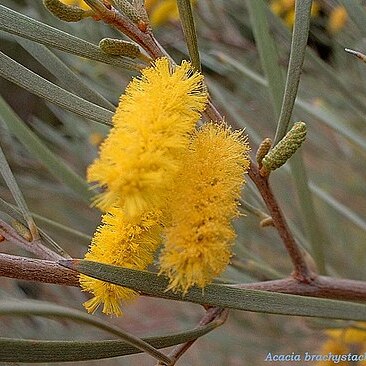Shrub branched at base, to 5 m high and wide. Branchlets with dense appressed hairs between dark resinous ribs; some red-glandular hairs on new growth. Phyllodes flat, occasionally subterete, straight, 4–11 (–18) cm long, 1–3 mm wide, finely striate, appressed-pubescent between longitudinal veins. Inflorescences single in axils; peduncles (2–) 3–10 mm long; spikes 10–30 mm long. Flowers 5-merous; sepals oblong, 0.5–0.8 mm (rarely to 1 mm) long, united in tube to 0.4 mm long or occasionally free, with long hyaline hairs on lobes; corolla 1.5–1.8 mm (rarely to 2 mm) long, pubescent to varying degrees; stamens to 3 mm long; ovary with dense ±appressed longish white hairs. Pods not stipitate, narrowly oblong in outline, straight, turgid, oval in section, to 7.5 cm long, 4–8 mm wide, dull brown with prominent yellowish resinous anastomosing longitudinal veins, elsewhere appressed-pubescent, tardily dehiscent. Seeds longitudinal, oblong, 5–8 mm long, 3–5 mm wide; aril small, terminal, pileate, pale.
More
It is an evergreen shrub. It grows to 3-6 m tall and spreads to 2-6 m wide. The stem is erect and it has many branches which hang down. The branches start just above ground level. The leaves (phyllodes) are thin, covered with bluish bloom and about 5-20 cm long. They are like pine needles and stiff and erect. They are greyish-green. The flowers are golden spikes. They are 1.5-3 cm long. The pods are brown. They are 2-8 cm long and 0.2-0.7 cm wide. They are straight, swollen, hairy and leathery.


